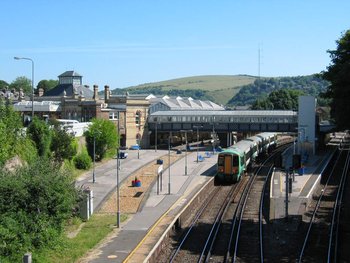Lewes
|
|
Template:Dablink Template:GBdot Lewes is the county town of East Sussex, England. It is situated in a gap in the South Downs where the river Ouse runs. It also serves as the administrative capital of the Lewes district.
To the east of the town the downs rise sharply forming a large chalk cliff that can be seen for many miles. The adjacent part of the town is known as Cliffe. The southern part of the town is known as Southover.
The name Lewes comes from the Anglo-Saxon word "Hlew", which means "Hill". The town is indeed largely built on a hill.
The town was the site of the historic Battle of Lewes in 1264. It is the location of several historic buildings, including Lewes Castle, the remains of Lewes Priory and the so-called Anne of Cleves House (which was owned, but never lived in, by the divorced queen). Lewes is also the headquarters of the Sussex Archaeological Society.
In 1768 Thomas Paine moved to Lewes to take up a post as an excise officer. He had previously apprenticed as an exciseman in Grantham in Lincolnshire from December 1762 before serving as exciseman for Alford from August 1764. He was sacked for claiming to have inspected goods when in fact he had only seen the documentation. His appeal to be re-instated was successful and he was appointed to a position in Grampound in Cornwall on 15 May 1767. He asked for leave to await another vacancy and was appointed to Lewes on 19 February 1768. It was in Lewes that he first began to take an active role in politics. He served on the town council and joined the local debating society called the Headstrong Club, which met at the White Hart Inn. Upon demanding a higher salary he was sacked as an excise officer for a second time. He responded by publishing a pamphlet entitled The Case of the Officers of Excise.
On December 27, 1836, an avalanche occurred in Lewes, the worst ever recorded in England. It was caused by a large build-up of snow on the nearby cliff slipping down onto a row of cottages called Boulder Row (now part of South Street). About fifteen people were buried, and eight of these died. A pub in South Street is named The Snowdrop in memory of the event.
| Contents |
The Lewes Bonfire
The town is famous for its annual Guy Fawkes night celebrations on the 5th of November. In Lewes this event not only marks the date of the uncovering of the Gunpowder Plot in 1605, but also commemorates the memory of 17 Protestant martyrs who were burnt at the stake in the town during the Marian persecutions of 1555 - 1557.
The current celebrations take the form of a series of torchlit processions through the town. The event is organised by the local bonfire societies. Lewes itself has seven bonfire societies (Nevill is a children's society and holds its celebrations a week or two before the 5th November; Southover, which disbanded in 1985, reformed in 2005 and plan to march with Cliffe) and a number of nearby towns have their own bonfire societies. The other five local bonfire societies from the town (Borough, Cliffe, Commercial Square, South Street and Waterloo) each proceed on their own route accompanied by a number of other societies from the neighbouring towns. Each bonfire society has its own traditional costumes (ranging from Tudor dress to Mongol warriors). A number of large effigies (effigies don't contain fireworks when dragged through the street, they are dummies, but the tableaux do contain fireworks) are drawn though the streets. Effigies of Guy Fawkes and Pope Paul V, who became head of the Roman Catholic Church in 1605 feature every year. In addition each of the five local societies creates a topical effigy, and the Cliffe society displays on pikes the heads (also in effigy!) of its current "Enemies of Bonfire". In 2001 an effigy of Osama bin Laden ensured that the annual event received more press attention than usual. The effigy was featured on the front page of a number of national newspapers. To mark the demise of the 17 martyrs, 17 burning crosses are carried through the town, and a wreath-laying ceremony occurs at the War Memorial in the centre of town. A "tar barrel" is also thrown into the river Ouse. The festivities culminate in five separate bonfire displays, where the effigies are destroyed by firework and flame. Up to 80,000 people have been known to attend this local spectacle.
In October of 2000 the town suffered major flooding. The commercial centre of the town and many residential areas were devastated. The flooding occurred during an intense period of severe weather throughout the UK. In a government report into the nationwide flooding, Lewes was officially noted the most severely affected location. The train station (pictured) temporarily looked like a canal.
Politics
Lewes is the seat of three administrative councils. The Town Council; Lewes District Council and East Sussex County Council. All three councils are currently held by the Liberal Democrats. The current Member of Parliament for the Lewes constituency is also a Liberal Democrat. Norman Baker won the seat in the United Kingdom general election, 1997 from the longstanding Conservative Party representative Tim Rathbone. Tim Rathbone had held the seat since 1974, when he took over from the previously longstanding Tory MP, Sir Tufton Beamish. Rathbone's defeat marked the end of over a century of Conservative representation.
Places of interest
External links
- Lewes Bonfire Council (http://www.lewesbonfirecouncil.org.uk/)
- Lewes District Council (http://www.lewes.gov.uk/)
- Lewes Football Club (http://www.lewesfc.com/)
- Friends of Lewes (http://www.friends-of-lewes.org.uk/index.html)
- Lewes Footpaths Group (http://www.lewesfootpathsgroup.org.uk/)
- Lewes Flood Action (http://www.lewes-flood-action.org.uk/)
- Lewes Chamber of Commerce (http://www.leweschamber.org.uk/)de:Lewes (England)


